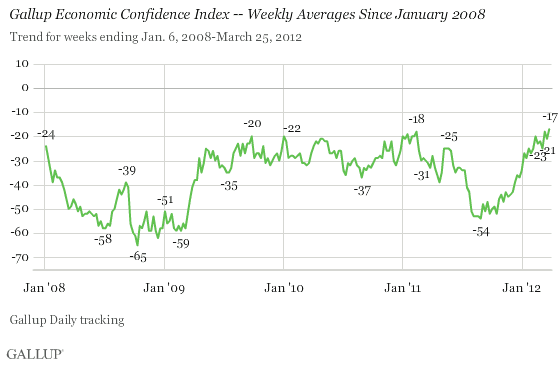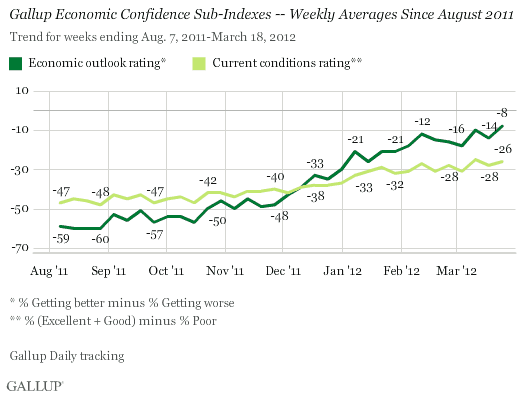PRINCETON, NJ -- U.S. economic confidence improved to -17 in the week ending March 25 from -21 the prior week. Economic confidence is now by one point at the highest weekly level Gallup has recorded since it started Daily tracking of confidence in January 2008.

Americans' economic confidence matched its previous high of -18 during the week ending March 11, 2012. Economic confidence was also at -18 during the week ending Feb. 13, 2011. A week ago, Gallup reported that economic confidence fell back to -21, perhaps signaling that concerns over soaring gas prices more than offset the lingering positive effects of the government's positive February unemployment report released on Friday, March 9.
While -17 is a marginal improvement in terms of a new high, it does place current economic confidence at its best weekly level of the past four years. Economic confidence also improved in early 2011, climbing to a weekly high of -18 in February. However, that enthusiasm dissipated quickly. Economic confidence plunged to -33 during the comparable week in March of a year ago.
The Gallup Economic Confidence Index includes two components: Americans' ratings of current economic conditions and their perceptions of whether the economy is getting better or getting worse. Slight improvements on both dimensions led to last week's increase in overall economic confidence.

The percentage of Americans saying the economy is "getting better" increased to 44% last week, while the percentage saying it is "getting worse" fell to 52%. This is the best weekly "getting better" level since Gallup Daily tracking began in January 2008.
Also, consumers' "poor" ratings of the economy are now at 41%, compared with 42% the prior week. This is one of Americans' more positive "poor" ratings of current economic conditions over the past four years.
Bottom Line
Americans' confidence in the economy is at its best level in four years, despite high gas prices. This suggests that the moderately improving economy and, in particular, the improving job situation are offsetting, at least in part, the drag of gas prices on consumer perceptions of the economy.
If U.S. economic confidence continues to improve and breaks out to higher levels not seen over the past four years, that could be good news for President Obama. Gallup analysis suggests that higher economic confidence is linked to higher presidential approval ratings in early 2012. Thus, relatively small gains in economic confidence from here on out could send the president's approval rating above 50%, much improving his chances for re-election.
However, Federal Reserve Board Chairman Ben Bernanke, addressing the National Association for Business Economics on Monday, noted that while the jobs situation has clearly improved, "conditions remain far from normal." He went on to point out that "jobs and hours worked remain well below pre-crisis peaks, even without adjusting for growth in the labor force."
Right now, Gallup's behavioral economic measures reflect the modestly improving economy. Gallup's Job Creation Index and consumer spending measure are also up this month.
Still, as the chairman suggested, reducing the jobless rate further will probably require "a more rapid expansion of production and demand from consumers and businesses." That is, it seems unlikely that the U.S. economy can continue to make progress in reducing the unemployment rate without stronger economic growth. If there is more rapid economic growth, however, it would mean good things for jobs and the economy.
Gallup.com reports results from these indexes in daily, weekly, and monthly averages and in Gallup.com stories. Complete trend data are always available to view and export in the following charts:
Daily: Employment, Economic Confidence, Job Creation, Consumer Spending
Weekly: Employment, Economic Confidence, Job Creation, Consumer Spending
Read more about Gallup's economic measures.
View our economic release schedule.
Survey Methods
Results for the week ending March 25, 2012 are based on 3,479 telephone interviews conducted as part of Gallup Daily tracking with adults aged 18 and older, living in all 50 U.S. states and the District of Columbia, selected using random-digit-dial sampling. For results based on this weekly sample of national adults, one can say with 95% confidence that the maximum margin of sampling error is ±3 percentage points.
Interviews are conducted with respondents on landline telephones and cellular phones, with interviews conducted in Spanish for respondents who are primarily Spanish-speaking. Each sample includes a minimum quota of 400 cell phone respondents and 600 landline respondents per 1,000 national adults, with additional minimum quotas among landline respondents by region. Landline telephone numbers are chosen at random among listed telephone numbers. Cell phone numbers are selected using random-digit-dial methods. Landline respondents are chosen at random within each household on the basis of which member had the most recent birthday.
Samples are weighted by gender, age, race, Hispanic ethnicity, education, region, adults in the household, and phone status (cell phone only/landline only/both, cell phone mostly, and having an unlisted landline number). Demographic weighting targets are based on the March 2011 Current Population Survey figures for the aged 18 and older non-institutionalized population living in U.S. telephone households. All reported margins of sampling error include the computed design effects for weighting and sample design.
In addition to sampling error, question wording and practical difficulties in conducting surveys can introduce error or bias into the findings of public opinion polls.
For more details on Gallup's polling methodology, visit www.gallup.com.
